
Year 1043 (MXLIII) was a common year starting on Saturday of the Julian calendar.

Vsevolod I Yaroslavich was Grand Prince of Kiev from 1078 until his death in 1093.
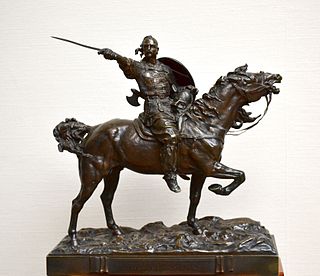
Sviatoslav or Svyatoslav I Igorevich was Prince of Kiev from 945 until his death in 972. He is known for his persistent campaigns in the east and south, which precipitated the collapse of two great powers in Eastern Europe, Khazaria and the First Bulgarian Empire. He conquered numerous East Slavic tribes, defeated the Alans and attacked the Volga Bulgars, and at times was allied with the Pechenegs and Magyars (Hungarians).

Rogneda Rogvolodovna, also known as Ragnhild (Ragnheiðr), is a person mentioned in the Primary Chronicle as having been a princess of Polotsk, the daughter of Rogvolod (Ragnvald), who came from Scandinavia and established himself at Polotsk in the mid-10th century. Vladimir the Great is narrated as having killed her father and taking her as one of his wives.

Iziaslav Yaroslavich was Prince of Turov and Grand Prince of Kiev.
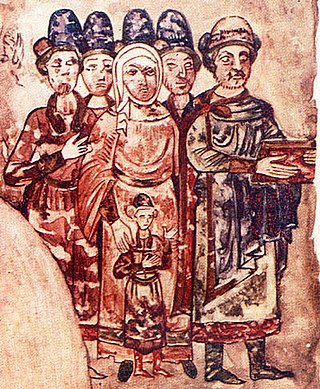
Sviatoslav II Iaroslavich or Sviatoslav II Yaroslavich was Grand Prince of Kiev from 1073 until his death in 1076. He was a younger son of Yaroslav the Wise, the grand prince of Kiev. He is the progenitor of the Sviatoslavichi branch of Rurikids.
Sviatopolk II Iziaslavich was Grand Prince of Kiev from 1093 to 1113. He was not a popular prince, and his reign was marked by incessant rivalry with his cousin Vladimir Monomakh.

Vseslav Bryachislavich was Prince of Polotsk (1044–1101) and Grand Prince of Kiev (1068–1069). Together with Rostislav Vladimirovich and voivode Vyshata, they created a coalition against the Yaroslaviches' triumvirate. Polotsk's Cathedral of Holy Wisdom, completed in the mid-11th century, is one of the most enduring monuments from his reign and the oldest stone building in Belarus.
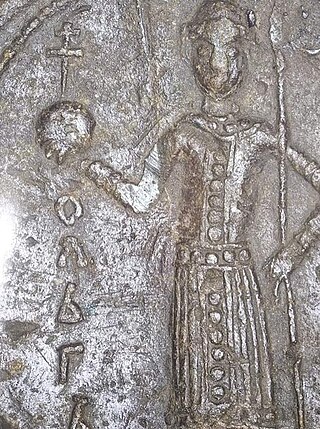
Oleg Svyatoslavich was a prince from Kievan Rus' whose equivocal adventures ignited political unrest in the country at the turn of the 11th and 12th centuries. He reigned as Prince of Chernigov from 1097 to 1115, and was the progenitor of the Olgovichi family.

The Principality of Chernigov was one of the largest and most powerful states within Kievan Rus'. For a time the principality was the second most powerful after Kiev. The principality was formed in the 10th century and maintained some of its distinctiveness until the 16th century. The Principality of Chernigov consisted of regions of modern-day Ukraine, Belarus, and Russia.
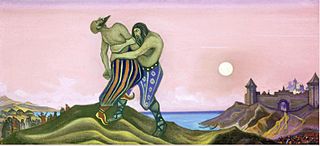
Mstislav Vladimirovich was the earliest attested prince of Tmutarakan and Chernigov in Kievan Rus'. He was a younger son of Vladimir the Great, the grand prince of Kiev. His father appointed him to rule Tmutarakan, an important fortress by the Strait of Kerch, in or after 988.
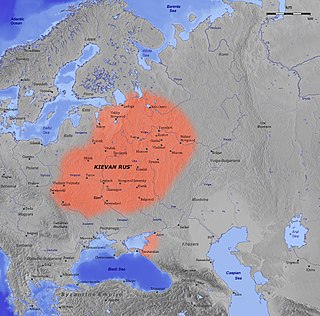
The intervention in the Kievan succession crisis of 1015–1019 by the Polish ruler Bolesław I the Brave was an episode in the struggle between Sviatopolk I and his brother Yaroslav for the grand princely title of Kiev. It occurred when Sviatopolk's father-in-law Bolesław, ruler of Poland, intervened on Sviatopolk's behalf.
Boniak, Bonyak or Maniac, also known as Boniak the Mangy, was "one of the most prominent Cuman chieftains" in the late 11th century and the early 12th century. He headed a powerful Cuman tribe or clan that inhabited the steppes to west of the Dnieper River. He supported the Byzantines against the Pechenegs in the Battle of Levounion in 1091. He defeated Coloman, King of Hungary in 1097 or 1099.

The Principality of Pereyaslavl was a regional principality of Kievan Rus' from the end of 9th century until 1323, based in the city of Pereyaslavl on the Trubizh River.

The Principality of Smolensk was a Kievan Rus' lordship from the 11th to the 16th century. Until 1127, when it passed to Rostislav Mstislavich, the principality was part of the land of Kiev. The principality gradually came under Lithuanian influence and was incorporated into the Grand Duchy of Lithuania in 1404. The principality was reorganized into the Smolensk Voivodeship in 1508. The Principality of Moscow controlled the city from 1514 to 1611, then it was recaptured by the Polish–Lithuanian Commonwealth. Tsardom of Russia recaptured the city in 1654.

The Principality of Murom, also referred to as the Murom-Ryazan Principality until the mid-12th century, was a principality with its capital in Murom, now in Vladimir Oblast, Russia. Murom lay in an area that was strongly Finnic and for much of its medieval history, located in the homeland of the Muromians. In 1392, it was incorporated into the Grand Principality of Moscow.
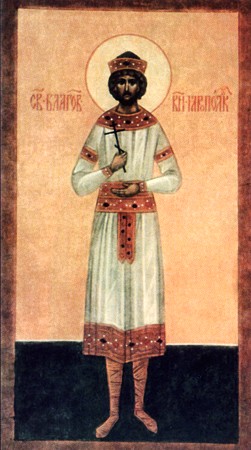
Yaropolk Iziaslavich or Yaropolk Iziaslavych was a Kniaz (prince) during the eleventh-century in the Kievan Rus' kingdom and was the King of Rus (1076–1087). The son of Grand Prince Iziaslav I of Kiev (Kyiv) by a Polish princess named Gertruda, he is visible in papal sources by the early 1070s but largely absent in contemporary Rus sources until his father's death in 1078. During his father's exile in the 1070s, Yaropolk can be found acting on his father's behalf in an attempt to gain the favor of the German emperors and the papal court of Pope Gregory VII. His father returned to Kiev in 1077 and Yaropolk followed.
Rusʹ Khaganate, or kaganate of Rus is a name applied by some modern historians to a hypothetical polity suggested to have existed during a poorly documented period in the history of Eastern Europe between c. 830 and the 890s.

Sudislav Vladimirovich was Prince of Pskov from 1014 to 1036. He was imprisoned by his brother, Yaroslav the Wise, Grand Prince of Kiev, in about 1035. He was liberated from the prison in 1059 and died as a monk in a monastery in Kiev.
Iaroslav Sviatopolkovich, also known as Iaroslav or Yaroslav Sviatopolchich, was Prince of Volhynia from 1100 to 1118.















